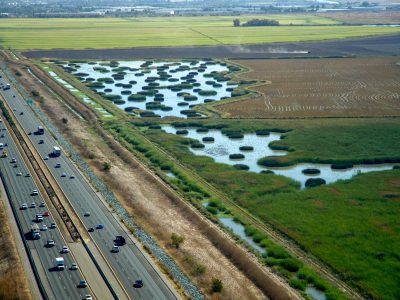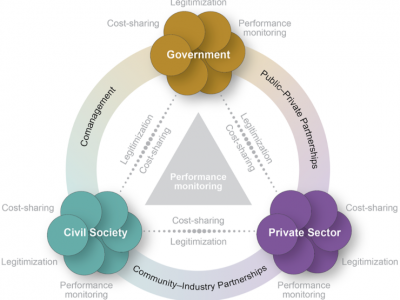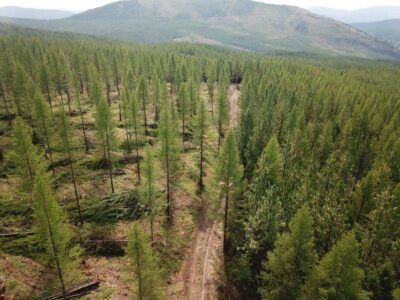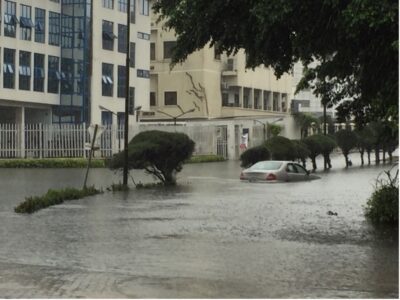Can we govern large-scale green infrastructure for multiple water benefits?
by Lidia Cano Pecharroman, Christopher Williams, Nell Green Nylen, and Michael Kiparsky
Green infrastructure is increasingly emphasized as an alternative, novel path for water infrastructure. The possibilities are intriguing: Can we transition from a landscape dominated by siloed grey infrastructure (think concrete and steel, constructed for one or a few key outcomes like water supply or flood control) to one that centers natural processes in water infrastructure to achieve multiple goals?
In a recently published paper, we explore the emerging possibilities of green infrastructure through a governance lens, focusing on large scale implementation. We find that one of the chief opportunities around such infrastructure projects lies, in concept, in joint funding and financing. Other ingredients such as stakeholder buy-in and effective performance monitoring systems also need to be added to the mix to achieve success.
We examined four case studies of what we term Large Scale Green Infrastructure (LSGI). We define LSGI as planned natural or hybrid (green and grey) systems that materially impact water security at the watershed scale. To illustrate, urban green infrastructure is becoming increasingly familiar – curbs that funnel water through cities are now augmented by vegetated swales that absorb runoff and reduce stormwater impacts to ecosystems, while providing aesthetic and other benefits as well. LSGI projects, operating at larger scale, use natural processes like floodplain connections, infiltration to groundwater, and the benefits of vegetation to route, slow, and clean water on its way to creeks, streams and rivers, reducing flood risk, improving water quality, and augmenting habitat.
The natural processes embedded in LSGI can take many forms depending on the relevant water management objectives. Our cases consider distinct approaches to LSGI, some of which capitalize on natural processes alone, while others combine them

with built infrastructure. The Yolo Bypass Wildlife Area is a massive restored wetland habitat. The wetland contributes to flood control in the area, while coexisting with agricultural practices and providing a space for nature exploration, hunting and educational programs. Wetlands underpin the Tres Rios wetlands project in Arizona, but in this case they are designed to improve water quality, in lieu of expensive upgrades to a traditional wastewater treatment plant, and restore wildlife habitat. In the Forest to Faucets program in Colorado, forest restoration in key areas is proving to be pivotal for reducing forest fires, protecting against post-fire sedimentation in the riverbeds and creeks that feed the water supply, and improving ecosystem health. Similarly, in the DC Clean Rivers Project, a coordinated collection of green infrastructure installations reduces stormwater runoff, protecting the health of water bodies and simultaneously reducing heat island effects.
Considering the promise of LSGI, why are projects like these notable outliers rather than common practice?
Our findings suggest that LSGI projects face intertwined governance challenges that flow from their core strength: LSGI’s multi-benefit nature. These challenges—and their solutions—relate to cost sharing, performance monitoring, and legitimization. Many different stakeholders within government, civil society, and the private sector may stand to benefit from LSGI, creating the potential for collaborative funding and management. However, there is a gulf between the conceptual promise of cost sharing among diverse interests with access to different resources and operationalizing it in practice. In the cases we studied, cost sharing amongst stakeholders was ad hoc and limited. Stakeholders may lack familiarity or comfort with green infrastructure in general and frequently lack a robust understanding of the variety and level of benefits associated with a particular project. Notably, our research suggests that expanding LSGI performance monitoring to encompass key secondary benefits, in addition to the primary benefits sought by the main project proponent, could help clarify the nature and extent of the benefits actually achieved and how those benefits and burdens are distributed among stakeholders. This information could enable formal cost sharing that eases funding challenges. A clearer understanding of the performance and benefits of LSGI could also enhance its legitimacy, a pervasive challenge across our case studies. When stakeholders perceive LSGI as an appropriate alternative to or complement for grey infrastructure, there will be more buy-in for using LSGI as a tool to address water security challenges. We depict the interplay of these dynamics in the figure below.
More broadly, this research illustrates a recurring theme in our work at CLEE: improving and demonstrating technical feasibility is only the first step towards developing new, more effective paradigms for water and environmental management. The road to innovation invariably runs straight through institutions and governance.

Our recent journal article on this topic is available open access here:
Cano Pecharroman L., Williams C., Green Nylen N. & Kiparsky M. How can we govern large-scale green infrastructure for multiple water security benefits? Blue-Green Systems (2021) 3 (1): 62–80 https://doi.org/10.2166/bgs.2021.015
And for further related work from our team see: Green Nylen N. & Kiparsky M. 2015 Accelerating Cost-Effective Green Stormwater Infrastructure: Learning From Local Implementation. Wheeler Institute for Water Law & Policy, University of California at Berkeley School of Law, Berkeley, CA, p. 35.








Reader Comments